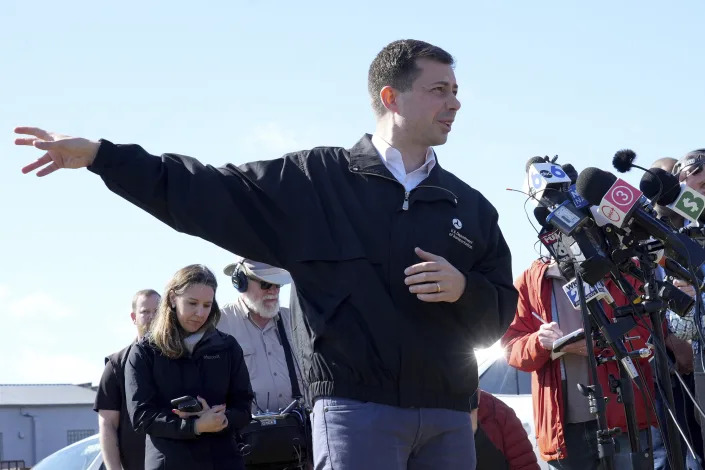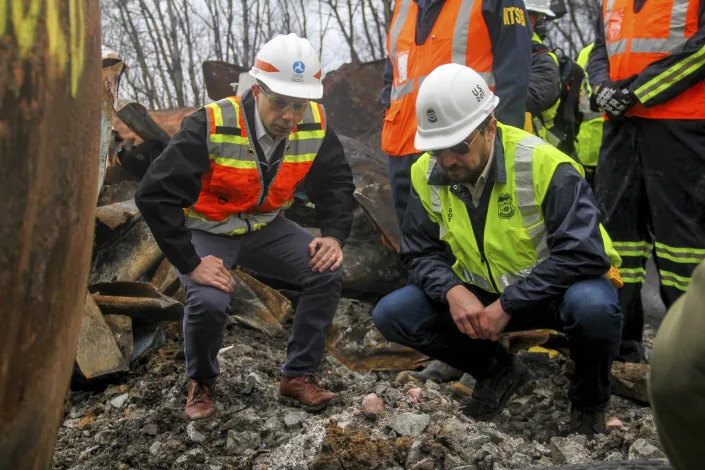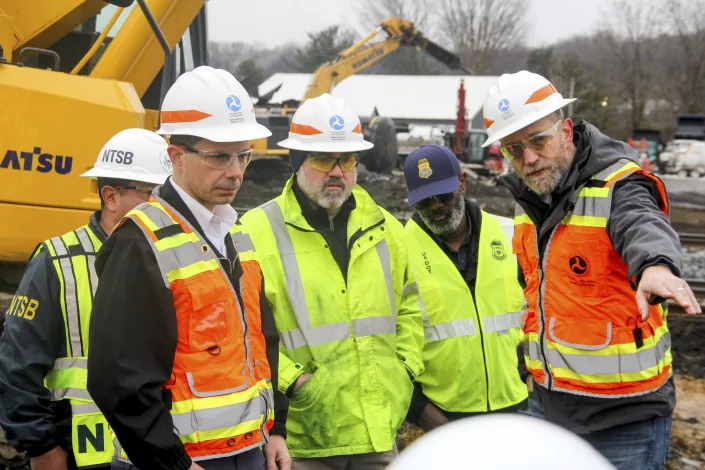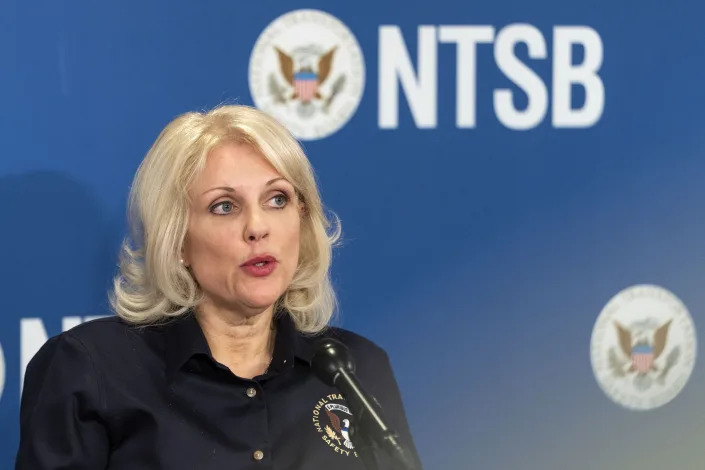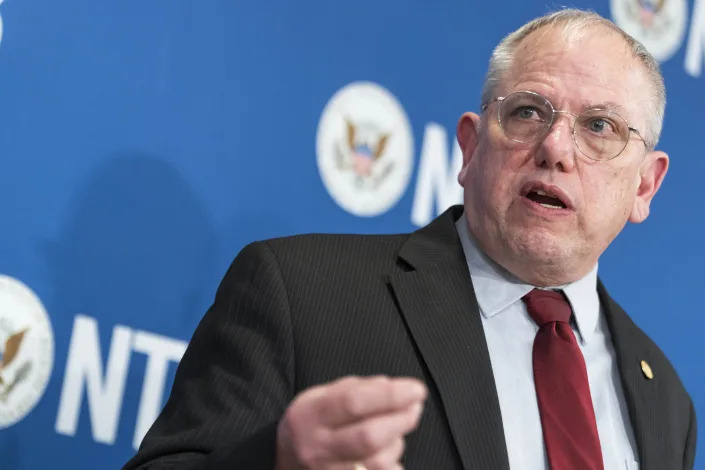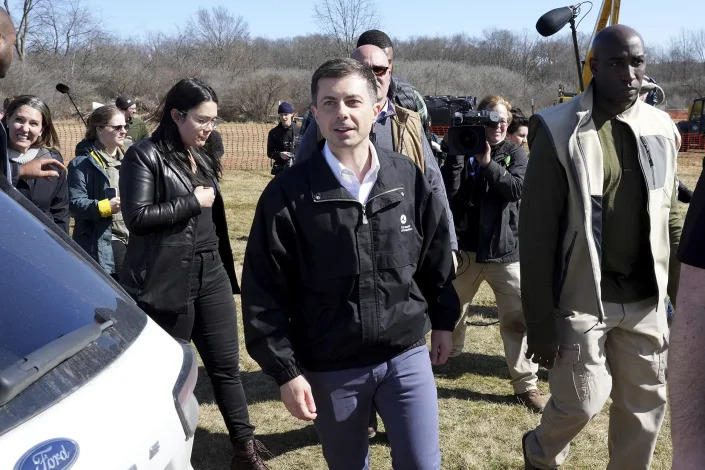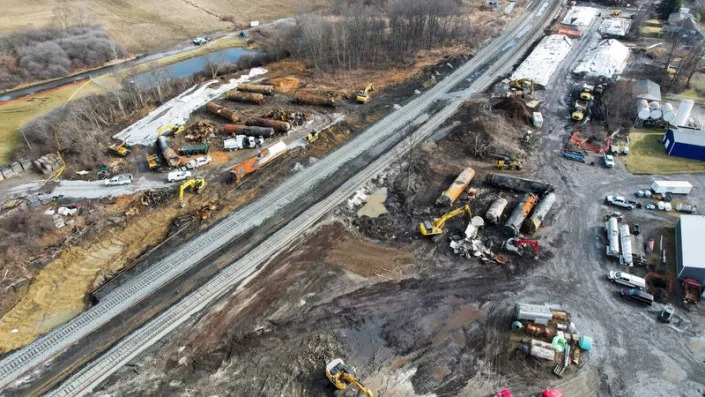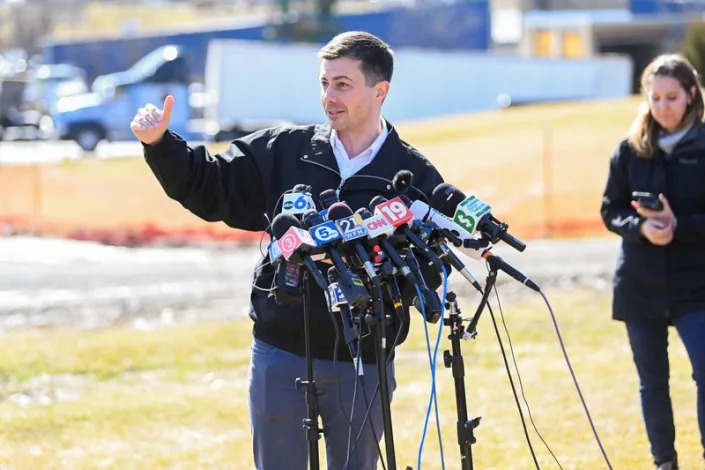Officials up estimate of animals killed by Ohio derailment to nearly 44,000

Julia Mueller
Thu, February 23, 2023
The Ohio Department of Natural Resources (ODNR) has upped its estimate for the number of animals killed by the derailment of train cars carrying hazardous chemicals in East Palestine, Ohio, to nearly 44,000.
The department estimates around 38,222 minnows were killed by the derailment within a 5-mile span, plus around 5,500 other species, including other small fish, amphibians, crayfish and macroinvertebrates, ODNR Director Mary Merks said in a statement.
The original estimate was approximately 3,500 dead aquatic species, based on observations from Feb. 6-7, shortly after the Feb. 3 derailment. ODNR’s team responded to the waterways the morning after the spill, but were warned by the Ohio EPA “that it was too dangerous to enter the water without specialized gear and equipment.”
Several of the 38 Norfolk Southern train cars that derailed in East Palestine earlier this month carried vinyl chloride, a hazardous and potentially cancer-causing chemical used in plastics production.
To avert an explosion, the chemicals were burned in an attempted “controlled release,” further stoking environmental concerns about the quality of the local land, air and water following the incident.
Although dead animals remain in the waterways affected by the chemical spill, Merks underscored that the animals are believed to have been killed “immediately after the derailment” and noted that live fish have since been observed returning to parts of the area.
“Because the chemicals were contained, we haven’t seen any additional signs of aquatic life suffering,” Merks said. She also noted no dead aquatic life was observed in the nearby Ohio River.
The ODNR estimate is based on a collected sample of dead aquatic species, and the department says it doesn’t believe any of the affected animals were endangered.
“We are awaiting test results of several non-aquatic animals including three birds, and an opossum,” Merks said. “We do not believe any of these animals were made sick by the train derailment, but we have submitted those specimens to the Ohio Department of Agriculture and will wait for those test results before making that judgement.”
The Hill

Julia Mueller
Thu, February 23, 2023
The Ohio Department of Natural Resources (ODNR) has upped its estimate for the number of animals killed by the derailment of train cars carrying hazardous chemicals in East Palestine, Ohio, to nearly 44,000.
The department estimates around 38,222 minnows were killed by the derailment within a 5-mile span, plus around 5,500 other species, including other small fish, amphibians, crayfish and macroinvertebrates, ODNR Director Mary Merks said in a statement.
The original estimate was approximately 3,500 dead aquatic species, based on observations from Feb. 6-7, shortly after the Feb. 3 derailment. ODNR’s team responded to the waterways the morning after the spill, but were warned by the Ohio EPA “that it was too dangerous to enter the water without specialized gear and equipment.”
Several of the 38 Norfolk Southern train cars that derailed in East Palestine earlier this month carried vinyl chloride, a hazardous and potentially cancer-causing chemical used in plastics production.
To avert an explosion, the chemicals were burned in an attempted “controlled release,” further stoking environmental concerns about the quality of the local land, air and water following the incident.
Although dead animals remain in the waterways affected by the chemical spill, Merks underscored that the animals are believed to have been killed “immediately after the derailment” and noted that live fish have since been observed returning to parts of the area.
Thu, February 23, 2023
The Ohio Department of Natural Resources (ODNR) has upped its estimate for the number of animals killed by the derailment of train cars carrying hazardous chemicals in East Palestine, Ohio, to nearly 44,000.
The department estimates around 38,222 minnows were killed by the derailment within a 5-mile span, plus around 5,500 other species, including other small fish, amphibians, crayfish and macroinvertebrates, ODNR Director Mary Merks said in a statement.
The original estimate was approximately 3,500 dead aquatic species, based on observations from Feb. 6-7, shortly after the Feb. 3 derailment. ODNR’s team responded to the waterways the morning after the spill, but were warned by the Ohio EPA “that it was too dangerous to enter the water without specialized gear and equipment.”
Several of the 38 Norfolk Southern train cars that derailed in East Palestine earlier this month carried vinyl chloride, a hazardous and potentially cancer-causing chemical used in plastics production.
To avert an explosion, the chemicals were burned in an attempted “controlled release,” further stoking environmental concerns about the quality of the local land, air and water following the incident.
Although dead animals remain in the waterways affected by the chemical spill, Merks underscored that the animals are believed to have been killed “immediately after the derailment” and noted that live fish have since been observed returning to parts of the area.
“Because the chemicals were contained, we haven’t seen any additional signs of aquatic life suffering,” Merks said. She also noted no dead aquatic life was observed in the nearby Ohio River.
The ODNR estimate is based on a collected sample of dead aquatic species, and the department says it doesn’t believe any of the affected animals were endangered.
“We are awaiting test results of several non-aquatic animals including three birds, and an opossum,” Merks said. “We do not believe any of these animals were made sick by the train derailment, but we have submitted those specimens to the Ohio Department of Agriculture and will wait for those test results before making that judgement.”
The Hill
The ODNR estimate is based on a collected sample of dead aquatic species, and the department says it doesn’t believe any of the affected animals were endangered.
“We are awaiting test results of several non-aquatic animals including three birds, and an opossum,” Merks said. “We do not believe any of these animals were made sick by the train derailment, but we have submitted those specimens to the Ohio Department of Agriculture and will wait for those test results before making that judgement.”
The Hill
ODNR: East Palestine train derailment killed roughly 40,000 fish
Paige Bennett, The Repository
Thu, February 23, 2023
The Ohio Department of Natural Resources says there are no signs of aquatic life suffering in and around East Palestine roughly three weeks after the train derailment.
Agency Director Mary Mertz said Thursday that officers have been on site every day since the Feb. 3 derailment of a Norfolk Southern train carrying toxic chemicals and believe all the fish killed as a result of the incident died immediately.
Officials estimated 38,222 minnows and around 5,550 other species, such as other fish, crayfish and amphibians, were killed during the derailment. The deaths occurred in a five-mile span within the impact area, which runs from the derailment site to Sulphur Run, Leslie Run, Bull Creek and North Fork Little Beaver Creek.
None of the species killed are threatened or endangered, Mertz said.
"Because the chemicals were contained, we haven't seen any additional signs of aquatic life suffering, and, in fact, we have seen live fish already return to Leslie Run," she said.
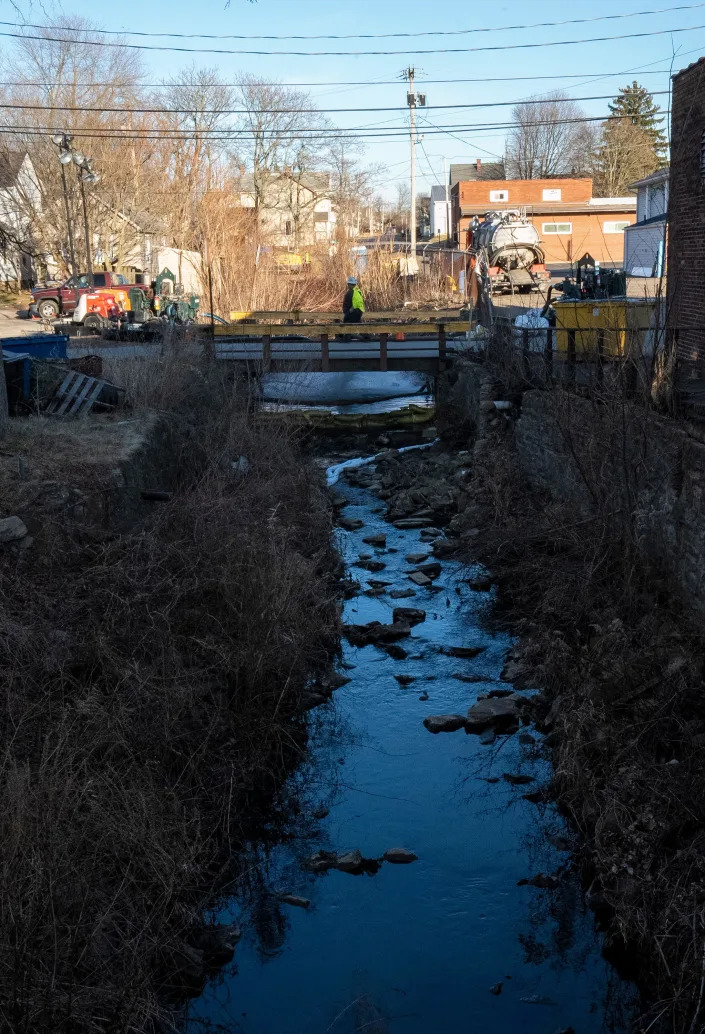
Workers pump water into a creek that runs through East Palestine.
The ODNR held a virtual news conference Thursday morning to discuss the impact on wildlife of the derailment and chemical burn of vinyl chloride to prevent a potential explosion. The U.S. Environmental Protection Agency has identified four other substances that leaked into the air, water and soil during the derailment: butyl acrylate, ethylhexyl acrylate, ethylene glycol monobutyl ether and isobutylene.
There have been anecdotal reports of animals in and around East Palestine becoming sick or dying. Murray & Murray, a Sandusky-based law firm, filed a lawsuit against Norfolk Southern that claims animals and fish are dying as far as 20 miles away from the derailment site.
A West Virginia University student who took videos of waterways in East Palestine told Cleveland 19 News he found tens of thousands of dead fish and frogs in the water.
Mertz said ODNR hasn't seen an impact on species that feed on or interact with the ones killed. The agency received reports of three dead birds and an opossum in the area and sent the animals to the Ohio Department of Agriculture for testing, which found no evidence of chemical poisoning.
"We have no reason to believe that those terrestrial animal deaths were as a result of the spill," she said.
A majority of the dead fish have been removed from the waterways.
ODNR will continue to monitor the environmental impact during cleanup. There is no time estimate for how long it will take for the ecological system to recover.
ODNR map by Rick Armon on Scribd
How did ODNR calculate aquatic deaths in East Palestine?
Mertz said ODNR officers arrived in East Palestine the morning after the derailment to survey the waterways to determine the impact on aquatic life. The Ohio EPA advised ODNR personnel that it was too dangerous to enter the water without specialized equipment. In response, ODNR consulted with Enviroscience, an environmental consulting firm that was already on site working to contain the spill.
Enviroscience used ODNR's standards to survey the water for dead aquatic species. They established four collection stations and gathered data on Feb. 6 and 7.
Officials previously said they found roughly 3,500 dead fish in local waterways, including 12 different species. Mertz said this estimate was based on visual observations, and the confirmed sample was 2,938 aquatic species, which was slightly smaller than the initial estimate.
Wildlife investigators at ODNR then applied a science-based calculation to the sample number to determine the total number of dead aquatic species.
Reach Paige pmbennett@gannett.com or on Twitter @paigembenn.
This article originally appeared on The Repository: East Palestine train derailment killed 40,000 fish
Thu, February 23, 2023
The Ohio Department of Natural Resources says there are no signs of aquatic life suffering in and around East Palestine roughly three weeks after the train derailment.
Agency Director Mary Mertz said Thursday that officers have been on site every day since the Feb. 3 derailment of a Norfolk Southern train carrying toxic chemicals and believe all the fish killed as a result of the incident died immediately.
Officials estimated 38,222 minnows and around 5,550 other species, such as other fish, crayfish and amphibians, were killed during the derailment. The deaths occurred in a five-mile span within the impact area, which runs from the derailment site to Sulphur Run, Leslie Run, Bull Creek and North Fork Little Beaver Creek.
None of the species killed are threatened or endangered, Mertz said.
"Because the chemicals were contained, we haven't seen any additional signs of aquatic life suffering, and, in fact, we have seen live fish already return to Leslie Run," she said.

Workers pump water into a creek that runs through East Palestine.
The ODNR held a virtual news conference Thursday morning to discuss the impact on wildlife of the derailment and chemical burn of vinyl chloride to prevent a potential explosion. The U.S. Environmental Protection Agency has identified four other substances that leaked into the air, water and soil during the derailment: butyl acrylate, ethylhexyl acrylate, ethylene glycol monobutyl ether and isobutylene.
There have been anecdotal reports of animals in and around East Palestine becoming sick or dying. Murray & Murray, a Sandusky-based law firm, filed a lawsuit against Norfolk Southern that claims animals and fish are dying as far as 20 miles away from the derailment site.
A West Virginia University student who took videos of waterways in East Palestine told Cleveland 19 News he found tens of thousands of dead fish and frogs in the water.
Mertz said ODNR hasn't seen an impact on species that feed on or interact with the ones killed. The agency received reports of three dead birds and an opossum in the area and sent the animals to the Ohio Department of Agriculture for testing, which found no evidence of chemical poisoning.
"We have no reason to believe that those terrestrial animal deaths were as a result of the spill," she said.
A majority of the dead fish have been removed from the waterways.
ODNR will continue to monitor the environmental impact during cleanup. There is no time estimate for how long it will take for the ecological system to recover.
ODNR map by Rick Armon on Scribd
How did ODNR calculate aquatic deaths in East Palestine?
Mertz said ODNR officers arrived in East Palestine the morning after the derailment to survey the waterways to determine the impact on aquatic life. The Ohio EPA advised ODNR personnel that it was too dangerous to enter the water without specialized equipment. In response, ODNR consulted with Enviroscience, an environmental consulting firm that was already on site working to contain the spill.
Enviroscience used ODNR's standards to survey the water for dead aquatic species. They established four collection stations and gathered data on Feb. 6 and 7.
Officials previously said they found roughly 3,500 dead fish in local waterways, including 12 different species. Mertz said this estimate was based on visual observations, and the confirmed sample was 2,938 aquatic species, which was slightly smaller than the initial estimate.
Wildlife investigators at ODNR then applied a science-based calculation to the sample number to determine the total number of dead aquatic species.
Reach Paige pmbennett@gannett.com or on Twitter @paigembenn.
This article originally appeared on The Repository: East Palestine train derailment killed 40,000 fish
